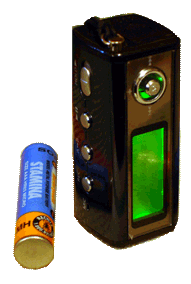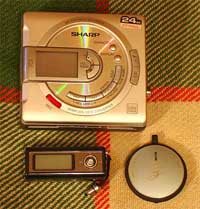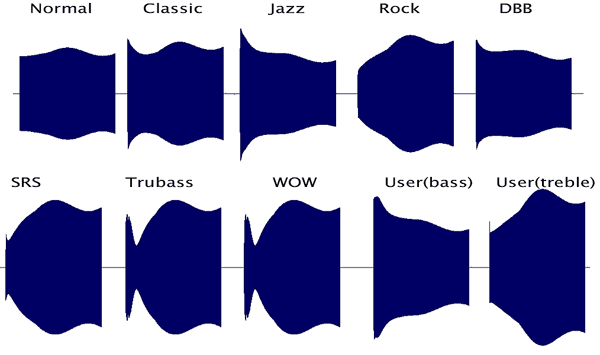Samsung flash-based
mp3-players sound quality issue (YP-T5, T5X,
T5H, T5V, YP-55 confirmed, T6, maybe others possible)
I decided to make this research
after I tested the sound
quality of my newly purchased Samsung Yepp T5X it was almost
unbearable. If you find this research is of use to you, then you may
use it for your own
research
Note:
Initially the review
was based on the experience with one particular YP-T5X model, but when
I saw the exact same result
testing the YP-55 player, I decide to address the issue on all Samsung
flash-based players. If you find any of my research is incorrect, I
would appreciate any input that you feel would be beneficial, in order
to rectify errors which may be shown
Table of contents
Description
 I have been
using different portable audio devices for some time now. First was
Sharp MD-MS701H, minidisc player, then the Eratech Beatsounds
EMP-Z, which has a coin-sized shape and claimed to be the smallest in
the
world (as far as I am aware it is stilll is!). The
latter had none of the special features nor even an LCD screen for that
matter,
so "the smallest", but is also "the simplest".
I have been
using different portable audio devices for some time now. First was
Sharp MD-MS701H, minidisc player, then the Eratech Beatsounds
EMP-Z, which has a coin-sized shape and claimed to be the smallest in
the
world (as far as I am aware it is stilll is!). The
latter had none of the special features nor even an LCD screen for that
matter,
so "the smallest", but is also "the simplest".
Having seend the Samsung Yepp YP-T5 (T5V, T5H,
T5X), I was impressed by the size and features on the unit the body
volume being only twice that of the EMP-Z. Having the body volume
just twice of the EMP-Z, and powered by one AAA cell and sported all
the modern features of flash-based portable players, such as FM-Tuner,
direct MP3 recordings, voice recorder and so on. There was no doubt I
would buy it.
Before purchasing my last test being the most important, sound. The
maximum volume was not impressive but EMP-Z had similar. The sound was
a little strange, lacking in highs. Anyway, this didn't stop me going
ahead and buying it. I assumed there would be something in the settting
which would allow some adjustments on custom settings.
However swithching to 'Normal
equalizer' mode did not solve the problem. I needed something more
concrete with confimrations from 'real measurements', rather than allow
the matter to stay "as is". The problems appeared to lie in the highter
frequences having a lower level than mid and low. I should add that I'm
talking about my personal feelings based on previous experience using
the same headphones with my new unit.
After some thought my chosen methods of research, which are by no
means unique, but will give other customers like myself with few
technical skills, a advantage.
Research
method
 There
is a special testing tone, often used for audio equipment testing,
tone
sweep sometimes found on the testing discs bundled with
Hi-Fi magazines.
This is special wave of sound which gradually changes frequency from
one
value to another. Generally the tone from 20 Hz to 20 kHz is being used
since this bandwidth is considered virtually audiable by the human ear.
When this test is used for acoustic devices, such as acoustic systems
or headphones, it allows you to compare what the frequences the device
produces and just how well it does it. Because of different hearing
conditions and the different hearing abilities of an individual, this
technique is probably not the best for an objective analysis.
There
is a special testing tone, often used for audio equipment testing,
tone
sweep sometimes found on the testing discs bundled with
Hi-Fi magazines.
This is special wave of sound which gradually changes frequency from
one
value to another. Generally the tone from 20 Hz to 20 kHz is being used
since this bandwidth is considered virtually audiable by the human ear.
When this test is used for acoustic devices, such as acoustic systems
or headphones, it allows you to compare what the frequences the device
produces and just how well it does it. Because of different hearing
conditions and the different hearing abilities of an individual, this
technique is probably not the best for an objective analysis.
So, these are the steps I used for my method
- Lets generate a tone sweep
in any good sound editor, lets assume
start frequency will be 50 Hz and end frequency 6000 Hz. For our goal
the essential parameter is amplitude, the
amplitude should be the same through the
whole fragment.
- The next step is to encode
the wave into MP3 file in order to
upload it later to the device. To be very accurate, let the bitrate
be 256 kbits.
- In all sound devices any
equalizing should be turned off,
otherwise
there's no use of testing at all. For Sharp we switch off Bass Boost.
The EMP-Z has no equalizer at all. Samsung is more complex,
under the items "Sound" you will find Normal, Classic,
Jazz, Rock, DBB
(Dynamic Bass Boost), User, SRS,
TruBass, WOW. They work as 'exclusive'
so
one and only one of these items can be selected at any one time. Let's
assume the 'Normal' mode is what
we need.
- After we upload our
testing mp3 file to all devices that
support mp3 (Beatsounds EMP-Z, Samsung Yepp T5) and record onto the
others (minidisc portable player Sharp MD-MS701H and minidisc deck Sony
MDS JE510).
- One by one we connect our
devices to a sound card and record the
fragments as digital files.
- We compare the result. For
a
good player the amplitude of the new recorded fragment should stay
constant. In other words, we
measure the frequency
response for each player.
If you're not familiar with the term, query the sentence in a search
engine, or read an article
at
pcavtech.com I did the same recently :-)
Note:
ADC (Analog-to-Digital
Converter) quality. It looks
like we would need a very good sound
card to to be accurate when converting output sound from the
player to the computer, but for our purpose it is only partly correct.
A bad soundcard may tend to convert sample values
innacurately. If so, we would continue to see a tendency in amplidute
change as one particular sample may be incorrectly
digitized, either the other samples would then be converted with the
same
value or all values will have stochastic nature and we will notice
this.
I may be wrong, anyway I used very good quality equippment, a Sony MDS
JE510 deck, connected by optical
cable to the computer.
Measurements
results
Unfortunately it is not possible to show the waves in original scale
since the pictures would be very long in this case. So scaled down
picutres will be shown and the ideal result
wave
I mentioned before should look like a simple rectangle. If there are
shifts or deviations, your eyes will notice this as a slightly
different figure.
I would appreciate your comments should your findings differ from
mine
(maxerist@gmail.com).
 |
Sharp
MD-MS701H
Very good results, the amplitude value �3.05 �� stayed almost
the
same through the whole fragment. The deviation value is about -0.02 +
0.002 dB
|
 |
 |
Beatsounds
EMP-Z. There is a little gradual
increase
from lows to highs, but this increase measuered in 0 to 0.06 dB, I'd
considered it a good result
|
 |
 |
Sony
MDS-JE510. The only non-portable
hero here.
Moreover, it is a Analog-to-digital stations for all other tests, so
when I decided to measure its values, the Sharp unit became a
soundcard. Headphones output was chosen for getting the wave. The
deviation is very small too. |
 |
 |
Samsung
Yepp YP-T5. The main
result. Take a look
at the shape on the right, can you call it a rectangle? I guess you
could. You can see it is exaggerated in the mid frequency and what is
interesting, the
shape is a very natural outline, not random at all. The
difference between the amplitude values
at the maximum and minimum points is nearly 1.65 dB.
Is it a
large or small difference? If your look at the same artice
at
pcavtech.com, you'll see that the authors considered 1 dB as sometimes
a noticable change. |
 |
What of the other
equalizer items in the Sound menu. May they
be used to make the sound more straight? Unfortunaetly the answers is
a resounding NO. Look at the shapes in the diagrams below. They show
the measured shape for every
item I mentioned before (Normal,
Classic,
Jazz,
Rock,
DBB
(Dynamic
Bass
Boost),
User,
SRS,
TruBass,
WOW).
Neither allows you to make the 'high
frequences' higher or even the same as middle. The so called 'user
preset' has 'Treble' parameter inside, but affects only 'mid
frequencies'. Settting Low and Treble to zero will not produce higher
'high frequences'.

A
little more accurate results with RMAA software
There is a great software program intended for the testing purposes,
called RMAA
( Rightmark Audio Analizer). They use a more accurate approach and
so I
give you the values that came from the software
RightMark
Audio Analyzer v.5.2 test. Testing chain: External loopback (line-out -
line-in). Sampling mode: 16-bit,
44 kHz Summary
| Test |
Sharp
MD-MS701 |
BeatSounds
EMP-Z |
Samsung
Yepp T5X |
| Frequency
response (from 40 Hz to 15 kHz), dB: |
+0.61, -0.49 |
+0.33, -0.32 |
+1.32, -0.78 |
| Noise
level, dB (A): |
-91.9 |
-93.6 |
-91.7 |
| Dynamic
range, dB (A): |
91.4 |
85.5 |
89.0 |
| THD,
%: |
0.016 |
0.0090 |
0.0061 |
| IMD,
%: |
0.029 |
0.044 |
0.024 |
| Stereo
crosstalk, dB: |
-79.2 |
-91.9 |
-91.1 |
Frequency
response

As you may see, RMAA shows a
little less values for the frequence response, 1.32 dB. (mine was
1.65), but anyway this result is much worse than those of other
players.
Just look at the blue line at the image above!
Quick
conslusion
My general feeling is that there's something wrong with this
player. If there's any modern 3d-sound chip inside or not.
I care for one thing: All
players
should have the ability to produce unchanged sound at the output jack
and not left to company standarts.
Some people acutally don't know what the
term frequency
response
means. There are many sites which show "Frequency response
20-20000 Hz", but in this case they had to call it 'Frequency
bandwidth'. If you
look at the same article
at
pcavtech, the point is that "Frequency response is
specified by the combination of three or four numbers".
You will not find other two values for Samsung YP-T5, YP-T5V, YP-T5H,
YP-T5X, YP-55 anywhere at their website. And I suppose that Samsung
just
didn't
provide us with the information.
Please let me know if you found
this article useful, additionally I
will be glad to get any comments on this article
(maxerist@gmail.com).
There is also a russian
version of this
article. I have advised the local representatives of Samsung about this
issue and they have said that they 'might' contact the engineers, but I
have had no other
comments from them at this time. I hope that this article will be read
by
someone from the Samsung who will take steps to change something in the
firmware
so the player will have a decent sound and this will be benefitical to
the individual and to the reputation of their firm. If Samsung do
respond to my observations, I will add their comments to this
page and any references to downloadable files or documentation they
deem suitable.
I also would like to give my
credits to the Beatsounds EMP-Z player.
Not only still the 'smallest in the world', but also one having the
very respectable sound, good
job, Beatsounds!
By the way, I have noted many rebranded version of their unit,
including Virgin
label this facts speak for themselves...
If
you want to make a similar test with your player, you can use
the same tone, I used. To download a 180k file,
click here.
It would be
great, if you share your results with me, so I may add a new test data
to this page (maxerist@gmail.com)
(c) Max Vlasov, 2004-2005,
maxerist@gmail.com
 There
is a special testing tone, often used for audio equipment testing,
tone
sweep sometimes found on the testing discs bundled with
Hi-Fi magazines.
This is special wave of sound which gradually changes frequency from
one
value to another. Generally the tone from 20 Hz to 20 kHz is being used
since this bandwidth is considered virtually audiable by the human ear.
When this test is used for acoustic devices, such as acoustic systems
or headphones, it allows you to compare what the frequences the device
produces and just how well it does it. Because of different hearing
conditions and the different hearing abilities of an individual, this
technique is probably not the best for an objective analysis.
There
is a special testing tone, often used for audio equipment testing,
tone
sweep sometimes found on the testing discs bundled with
Hi-Fi magazines.
This is special wave of sound which gradually changes frequency from
one
value to another. Generally the tone from 20 Hz to 20 kHz is being used
since this bandwidth is considered virtually audiable by the human ear.
When this test is used for acoustic devices, such as acoustic systems
or headphones, it allows you to compare what the frequences the device
produces and just how well it does it. Because of different hearing
conditions and the different hearing abilities of an individual, this
technique is probably not the best for an objective analysis.  I have been
using different portable audio devices for some time now. First was
Sharp MD-MS701H, minidisc player, then the Eratech Beatsounds
EMP-Z, which has a coin-sized shape and claimed to be the smallest in
the
world (as far as I am aware it is stilll is!). The
latter had none of the special features nor even an LCD screen for that
matter,
so "the smallest", but is also "the simplest".
I have been
using different portable audio devices for some time now. First was
Sharp MD-MS701H, minidisc player, then the Eratech Beatsounds
EMP-Z, which has a coin-sized shape and claimed to be the smallest in
the
world (as far as I am aware it is stilll is!). The
latter had none of the special features nor even an LCD screen for that
matter,
so "the smallest", but is also "the simplest".









